Explore the traditional souks in Dubai like a local. This insider’s guide reveals where to find authentic treasures, how to bargain like a pro, and what makes the Dubai Gold Souk a world-famous destination. Whether you're hunting for gold, spices, perfumes, or souvenirs, these tips will elevate your souk experience beyond the tourist trail.
The Local's Secret Guide to Shopping in Traditional Souks in Dubai

Dubai's traditional souks provide a remarkable contrast to the city's gleaming skyscrapers and modern malls. These vibrant marketplaces rank among the world's prominent shopping destinations. Centuries of trading traditions continue to thrive in the emirate's heart.
As you learn about souks in Deira, Dubai, you'll find amazing items from the impressive Gold Souk—the biggest gold bazaar in Arabia—to the aromatic Spice Souk that has served as a bustling marketplace for over 50 years. The old souks in Dubai keep their authentic character and help visitors learn about what to buy beyond typical tourist souvenirs. The Gold Souk features over 380 retailers who specialize in jewelry and precious stones, making it one of the world's best jewelry shopping destinations. Dubai's shopping options include handwoven fabrics, traditional perfumes, and special souvenirs throughout these historic markets.
This piece helps you explore Dubai's most important souks with local tips on how to explore them, what to look for, and how to get the best deals like a true Dubai resident. These traditional markets offer an authentic Middle Eastern shopping experience that remains vibrant today, whether you're visiting for the first time or returning. Here is a deep dive into Dubai Souks and the things to buy in Dubai.
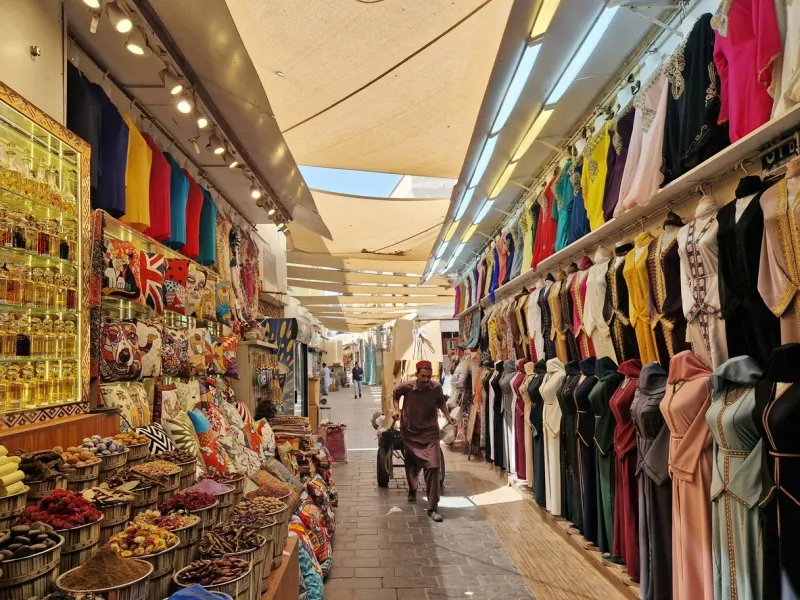
1. Gold Souk:
The Gold Souk welcomes you into a magical world where shops showcase yellow, white, and rose gold in stunning designs. This iconic marketplace sits in Deira's heart and has grown into one of the world's most famous gold markets over the last several years. It draws serious buyers and curious visitors from everywhere.
a) What makes the Gold Souk unique
The sheer size and concentration of precious metals make the Gold Souk stand out. You'll find over 380 retailers along Dubai Creek in Deira's narrow, covered lanes. This impressive marketplace keeps its traditional architecture instead of modern shopping center designs. The result? An authentic Arabian shopping experience.
The marketplace shines with its amazing variety of gold. You'll see everything from delicate 22-karat jewelry to massive statement pieces in shop windows. The selection here is unmatched. Gold prices are competitive because Dubai's taxes on gold are nowhere near what other countries charge. The Dubai Municipality strictly regulates gold quality, so you get exactly what you pay for.
The souk isn't just about gold—you'll find shops that specialize in diamonds, precious stones, platinum, and silver. Most people are amazed by how safe the area feels despite the valuable merchandise on display. This makes browsing comfortable even at night.
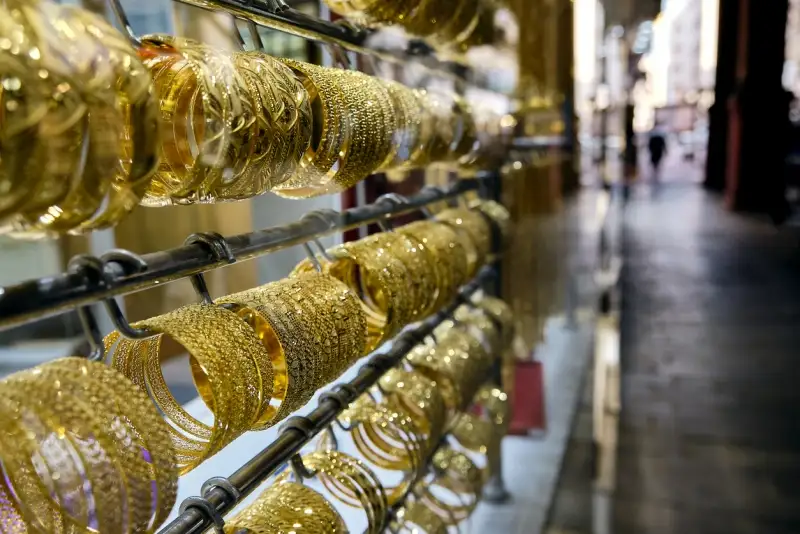
Customize Your Dream Vacation!
Get in touch with our local experts for an unforgettable journey.
Plan Your Tripb) Tips for buying gold and jewelry
You should know the simple basics of gold pricing before you buy anything at the Gold Souk. Sellers calculate prices using the daily international gold rate per gram plus a making charge that changes based on design complexity. These making charges usually run from 15% to 50% of the gold's value.
Look for these hallmark stamps to verify authenticity:
24K (99.9% pure gold)
22K (91.6% pure gold)
18K (75% pure gold)
14K (58.5% pure gold)
Ask for an official receipt with weight, purity, and price details. This paper works as proof of purchase and helps with insurance. The morning hours (10 AM to 1 PM) are great to shop when merchants can give you their full attention.
Many stores can ship your purchases straight to your home. This beats carrying valuable items while traveling. Visit several shops and compare designs and prices before you decide.
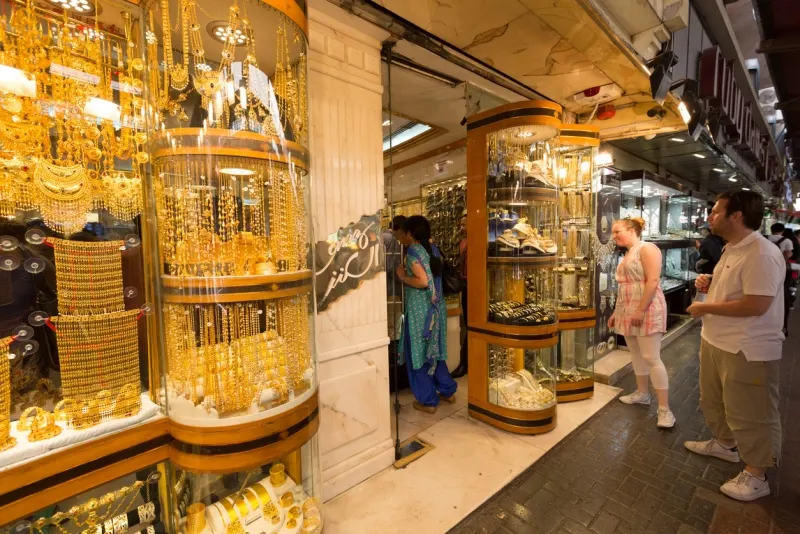
c) How to haggle like a local
The Gold Souk doesn't just allow haggling—it expects it. Here's how to negotiate like a Dubai local:
1. Start with the gold's weight price (you can't negotiate this—it follows market rates)
2. Try to lower the making charges instead
3. Make your first offer about 30-40% below the quoted price
4. Keep things friendly and respectful while you negotiate
5. Don't hesitate to walk away—merchants often call you back with better deals
Here's a pro tip: Merchants tend to offer better prices during quiet times or near closing. Building a connection works better than aggressive bargaining. Show real interest in their craft, and you might get a better deal. Cash might get you an extra discount, even though Dubai loves credit cards. Local people see negotiating as part of their culture. Think of it as a fun experience rather than a confrontation.
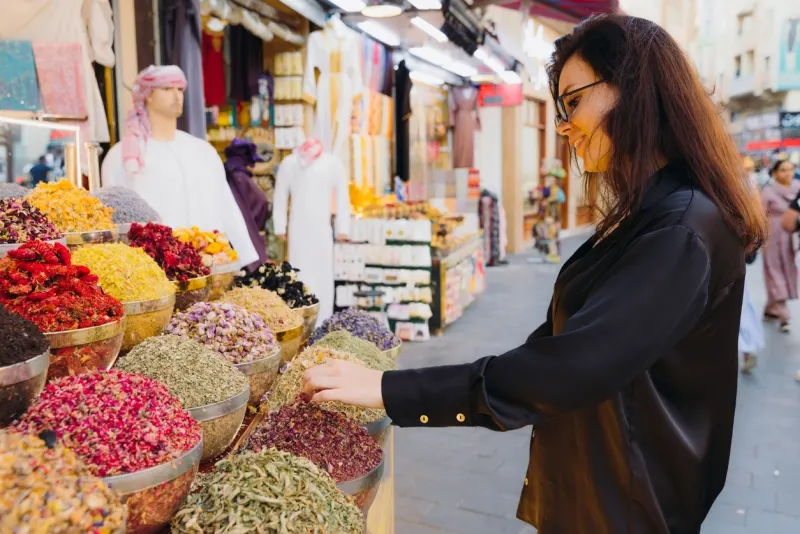
2. Spice and Perfume Souks:
Your nose catches the intoxicating aromas of saffron, cardamom, and exotic oils before your eyes spot Dubai's Spice and Perfume Souks. These aromatic marketplaces sit in the historic Deira district near Dubai Creek and offer a sensory experience unlike anything else in the emirate.
a) Spices to look out for in Deira
The bustling Spice Souk showcases a stunning kaleidoscope of colors and scents that have drawn chefs, home cooks, and curious visitors for generations. The narrow, winding alleys lead you past heaps of vibrant spices that catch your eye from every direction.
Saffron shines as the souk's crown jewel. This precious spice gives Middle Eastern cuisine its unique taste and comes in several grades and price points. The authentic Middle Eastern za'atar – a popular blend of thyme, sesame seeds, and sumac – adds earthy notes that enhance everything from bread to salads. Other spices you shouldn't miss include:
- Baharat: A rich blend of black pepper, cumin, cinnamon, and cloves that deepens the flavor of soups and stews
- Sumac: A tangy, citrus-like spice from dried berries that makes meat dishes more complex
- Iranian Fenugreek: These slightly bitter seeds give Iranian and Afghan cuisines their distinct taste
The Spice Souk's prices depend on quality and how well you bargain. A gram of saffron starts around 10 AED, while 100g of cardamom costs between 40-60 AED.
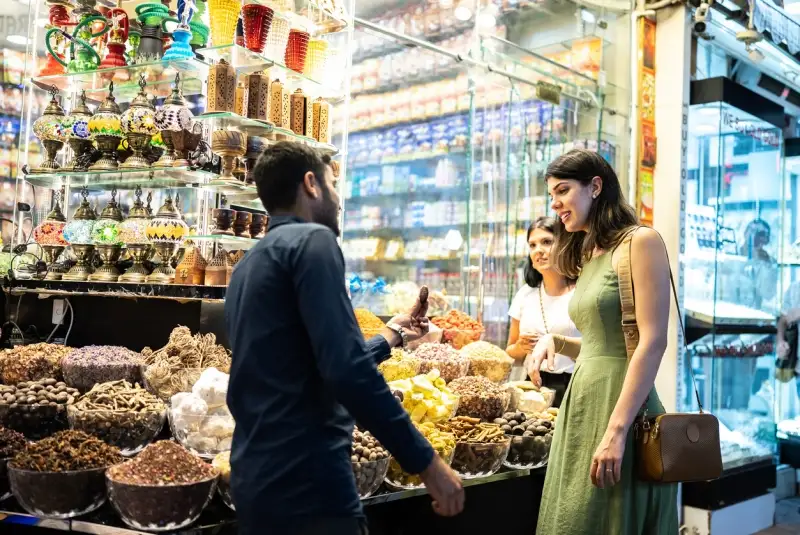
b) Perfume Souk: Oud, attars, and custom blends
The air grows sweeter as you step into the Perfume Souk, just east of the Spice Souk. This fragrant marketplace specializes in traditional Arabic scents that have shaped the region's identity for centuries. Oud stands out as the local favorite. This perfumed oil comes from agarwood resin and has a distinctive earthy scent that both Emirati men and women treasure. Bakhoor provides a gentler option – these agarwood chips soaked in fragrant oils create aromatic smoke when placed on a mabkhara burner. The souk shines with its custom blending services. Expert perfumers create unique scents that match your skin type and personality. These tailored fragrances usually mix:
- Musk and amber for warm, rich, honeyed notes
- Saffron for a deep, husky aroma
- Rose for a sweet, floral essence
70-year-old perfumeries like Ajmal and Swiss Arabian blend both traditional Arabic and French-inspired fragrances. Their skilled artisans combine oud, saffron, and touches of musk to create scents that last remarkably long.
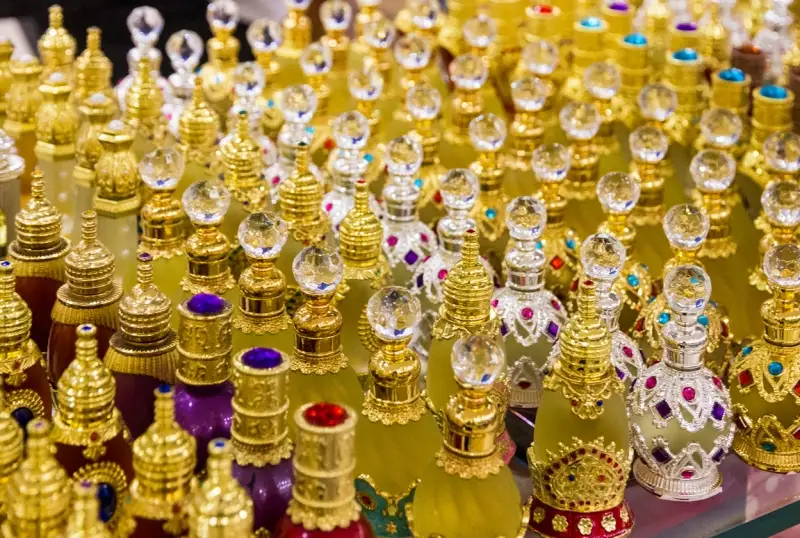
3. Textile and Grand Souks: Where Culture Meets Craft
The historic Bur Dubai neighborhood lies across Dubai Creek from the glittering Gold Souk. A world of vibrant fabrics and handmade treasures awaits in the Textile Souk and Grand Souk. These markets showcase Dubai's rich cultural heritage through colorful textiles and craftsmanship that define the region.
a) What to expect at the Textile Souk
The Dubai Textile Souk, known as the Old Textile Souk, sits among sand-colored buildings with beautifully restored architecture in the Al Fahidi district. Tall wooden arches line the covered alleys called "sikkas" to help with air flow - a must-have feature in Dubai's heat. These narrow lanes burst with color as fabrics from all over the world catch your eye.
You can visit the souk six days a week from 9 am to 8 pm, though vendors take lunch breaks between 2 pm and 4 pm, and stay closed on Fridays. The best time to shop is early morning before crowds arrive. Night visits give you a livelier feel with authentic sights and sounds of old Dubai.
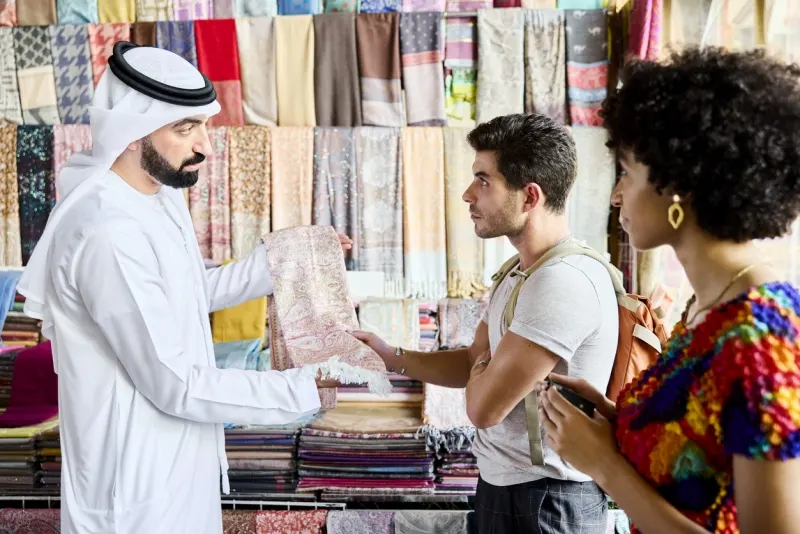
b) Traditional clothing and fabrics
Fashion lovers and designers will love this rich source of materials. You'll find endless choices of raw silk, cotton, and embroidered fabrics in every color and pattern imaginable. Quality determines prices - simple items cost 5-50 dirhams, while better tailoring runs about 60 dirhams for shirts or trousers and 150 dirhams for dresses. The market offers plenty of traditional garments:
- Abayas and kandoras (traditional Emirati attire)
- Pashmina shawls and scarves (65-200 dirhams for quality pieces)
- Embroidered lady slippers in vibrant colors
- Jalabiya and other regional clothing
Most shops offer tailoring services where you can pick fabric and have it made into custom clothes. "Hindi Lane" shows the area's strong Indian and Pakistani influence, with small shops selling bindis, bangles, and other cultural items next to traditional saris and salwar kameez.
Don’t miss the Gold Souk, Spice Souk, Perfume Souk, and Textile Souk, all located around Deira and Bur Dubai.
Souvenirs and local crafts at the Grand Souk
The Grand Souk Deira, 170 years old and near the harbor, holds an amazing collection of Arabian goods. Unlike the fabric-focused Textile Souk, this market sells more handicrafts and souvenirs. You'll find ceramic art, traditional Arab shoes, colorful shawls, and soft Persian rugs.
The distinctive crafts here show traditional Emirati artistry like Al-Sadu (Bedouin weaving with geometric patterns) and Talli (decorative embroidery using gold and silver threads). These aren't just souvenirs - they keep Emirati cultural identity and heritage alive.
Note that bargaining is part of the experience in both souks. Buying multiple items from one vendor often gets you better deals, especially when you show interest in their craftsmanship.
Tips for Shopping in the Old Souks in Dubai
1. How to Get Around in the Old Souks in Dubai?
A walk through Dubai's historic souks shows another side of the city's traditional charm. The Dubai Creek splits these bustling marketplaces between Deira and Bur Dubai and creates unique ways to travel that locals have used for generations.
a) Using Abra boats to cross the creek
Traditional wooden abra boats give you one of the most authentic—and economical—experiences in the city. You can join locals on these small water taxis for just 1 AED (approximately 25¢) as they shuttle between both sides of the creek. Each abra fits about 20 passengers and leaves when full. The system runs through four main stations:
- Deira Old Souk Abra Station (near the Spice Souk)
- Bur Dubai Abra Station (west of the Textile Souk)
- Al Sabkha Abra Station (southwest of Baniyas Square)
- Dubai Old Souk Abra Station
The ride takes just 5-7 minutes and gives you amazing views of traditional architecture and modern skylines. The experience shows you Dubai's commercial heart from a different point of view as other abras and larger dhows move across the waterway.
b) Walking routes between Deira and Bur Dubai
After crossing the creek, you can experience the souks on foot. The Al Fahidi Historical Neighborhood's distinctive wind towers lead naturally to the Textile Souk through narrow, shaded pathways from Bur Dubai. The abra station in Deira puts you just steps away from the Gold and Spice Souks. These pedestrian-only lanes give you a break from Dubai's car-focused streets. The quiet pathways make it hard to believe that the ultramodern city exists just miles away.
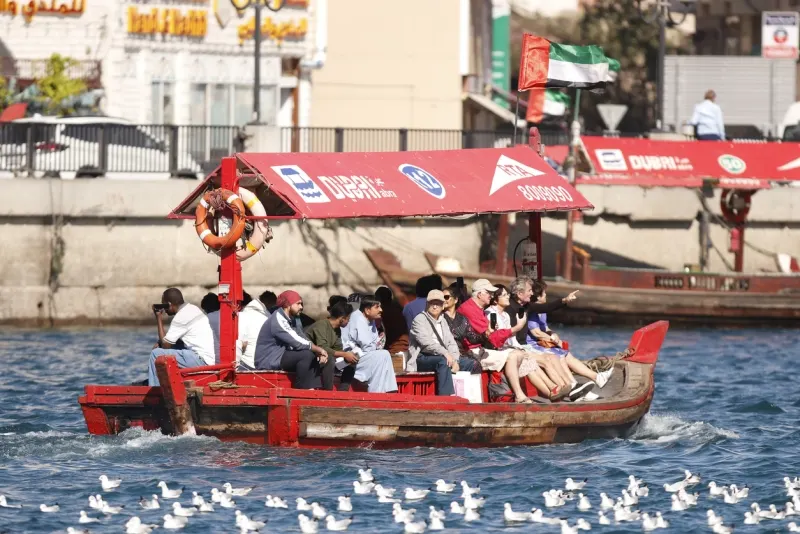
2. What are the best times to visit for fewer crowds?
The souks get busier throughout the day, so early mornings give you the most peaceful shopping experience. You might also find fewer crowds just before closing around 9 PM. The winter months (November-March) bring comfortable temperatures for walking through these outdoor marketplaces. The souks often close for lunch breaks between 2-4 PM, which makes morning or evening visits better choices.
3. How to identify authentic products?
The sensory overload makes spotting genuine products tricky without some know-how. Good spice vendors let you sample before buying. Real saffron shows vibrant red stigmas with orange tips – watch out for too-perfect coloring that might mean dyes.
Quality perfume oils need skin testing rather than paper strips because Arabic perfumes change with your body chemistry. Pure attars cost more than alcohol-based options but last much longer.
You must bargain at both souks. Vendors usually start prices 30-40% higher than they expect to get. Start your offer at half the stated price and work toward the middle. Authentic vendors know their stuff – they'll tell you where ingredients come from and how to use their products traditionally.
The best local purchases include spices unique to regional cooking, like local tea blends or premium date products, along with traditional fragrances that capture Arabian perfumery's essence.
Modern Takes on Traditional Markets
Dubai's marketplace experience takes on a refined twist with contemporary souks that blend traditional elements with modern luxury and convenience.
1. Souk Madinat Jumeirah: A luxury twist
Souk Madinat Jumeirah represents a sophisticated take on a traditional Arabian bazaar. This air-conditioned marketplace captures the essence of ancient souks through ornately patterned timber ceilings and brass burners with incense sticks. The atmosphere here is more ordered than the bustling old souks in Deira, Dubai, and you won't need to haggle. The souk features over 25 dining outlets among boutique stores that sell everything from exclusive art pieces to designer clothes. The meandering alleys reveal handcrafted jewelry, sequined fabrics, beaded slippers, and sparkly kaftans that showcase Arabian aesthetics. You can enjoy stunning views of the iconic Burj Al Arab from one of the many coffee shops.
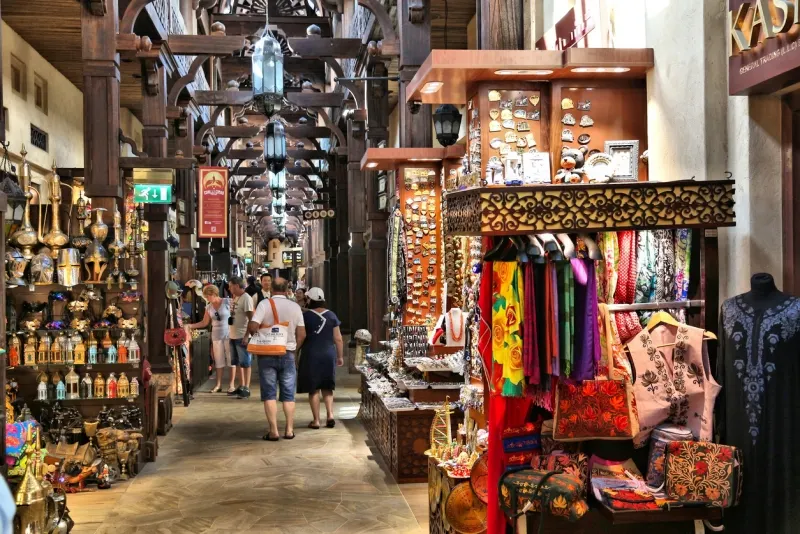
2. Souk Al Bahar: Shopping with a view
Souk Al Bahar, which means "Market of the Sailor" in Arabic, brings a contemporary interpretation of a traditional Arabian marketplace to Downtown Dubai's heart. The architecture showcases arched walkways, wooden lattice work, and stone façades that honor traditional design.
This indoor souk features over 20 shops and 17 restaurants along a captivating waterfront promenade.
Don't miss the chance to shop in Dubai Souks and plan your Dubai Tour with us!
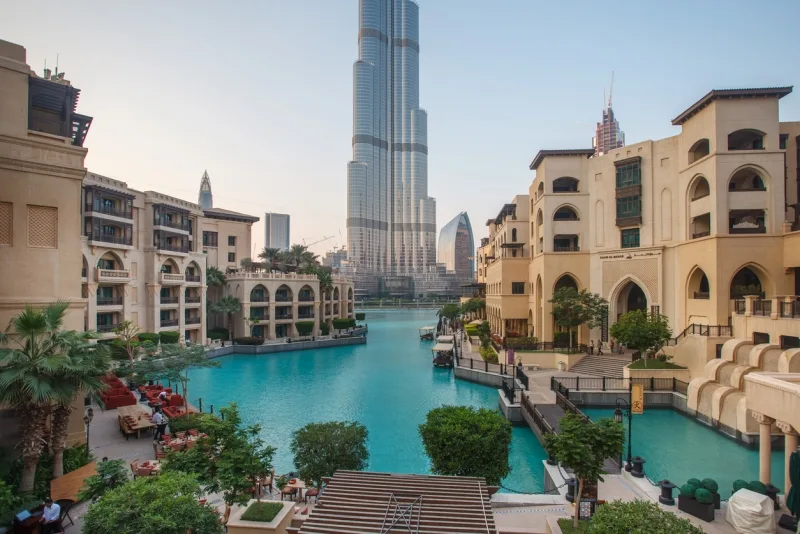
3. Al Seef: Blending heritage with modernity
Al Seef stands out with its two distinct sections: a historical area with restored 19th-century buildings and a modern district that opened in 2017. This waterside lifestyle destination sits along Dubai Creek, paying tribute to Dubai's first source of livelihood—the creek that once centered the pearl diving industry. The heritage area recreates an Emirati village through wind towers, coral-covered homes, and winding passageways called sikas. The modern section displays ultra-contemporary architecture with trendy boutiques and restaurants. Together, they create an experience through time that shows Dubai's rise froma fishing village to a global metropolis.
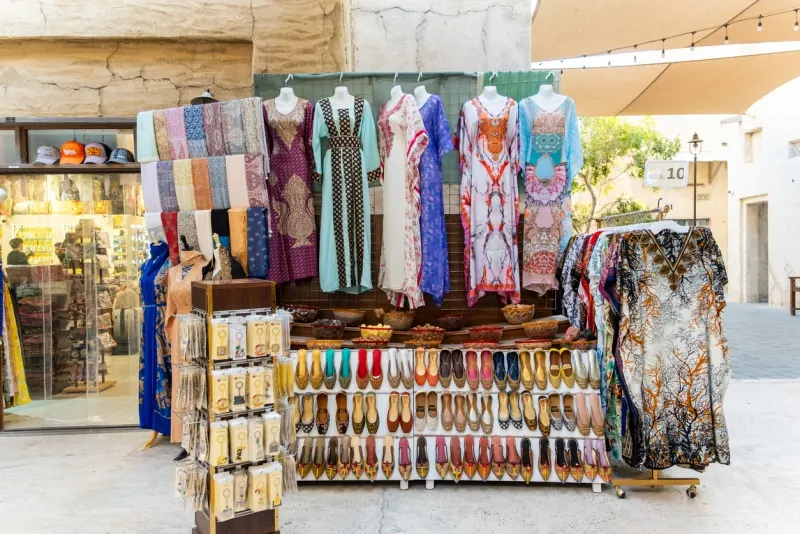
Dubai's traditional souks offer a unique shopping experience, showcasing treasures like gold jewelry, spices, and handcrafted textiles. These markets preserve ancient trading traditions while offering contemporary interpretations. They provide cultural immersion, welcoming friendly haggling and aromatic spice stalls. Despite rapid modernization, these souks maintain their authentic character, attracting both newcomers and seasoned travelers. The Gold and Spice Souks offer raw authenticity, while contemporary spaces like Al Seef provide refined comfort.
Early morning (9–11 AM) or late afternoon (4–6 PM) for cooler weather and smaller crowds.
Absolutely! Haggling is expected, start at half the asking price and negotiate from there.
Often, yes especially for textiles, souvenirs, and handcrafted goods. Gold prices depend on weight and daily market rate.
Spices, frankincense, oud perfumes, pashmina scarves, gold jewelry, and handmade souvenirs.
Dress modestly (especially in Deira and Bur Dubai) out of respect for local culture.
Go with a local guide or ask locals for hidden shops. Be polite, smile, and take your time exploring, the best finds aren’t always obvious.
Related Articles
Keep the inspiration going with these handpicked travel reads.
